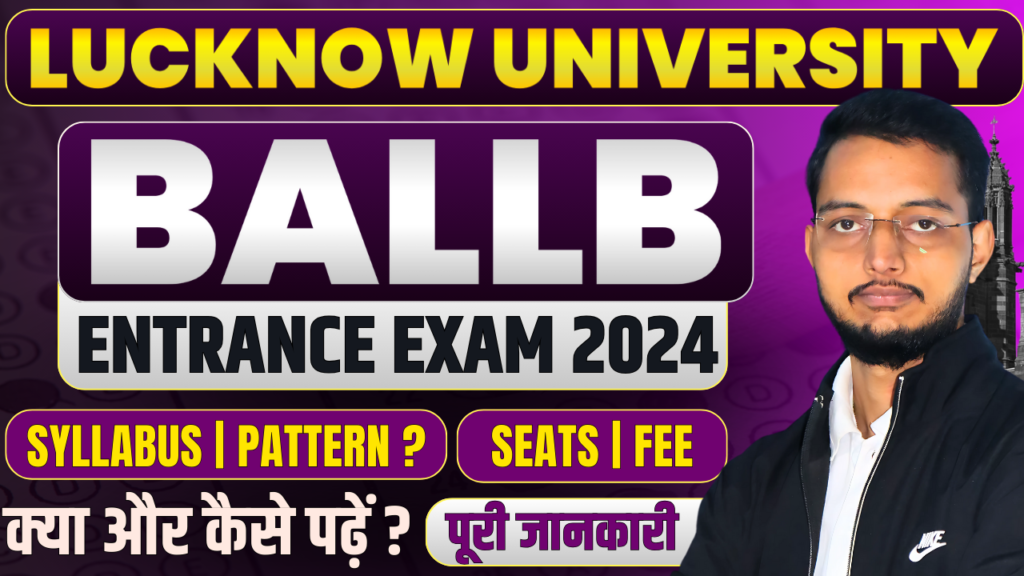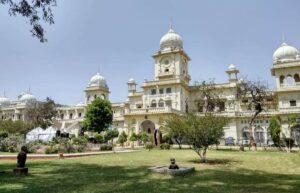
Lucknow University BALLB Entrance Exam Pattern
The exam has 100 multiple-choice questions, and you have 90 minutes to complete it. There’s no negative marking, so you won’t lose points for wrong answers. Each correct answer gives you 2 marks, with a total score of 200. The questions are available in both Hindi and English, so you can choose the language you’re more comfortable with. This format lets you focus on answering without worrying about losing points for mistakes.
| Elements | Response |
|---|---|
| Exam Type | MCQs Based Pen Paper |
| Paper Medium | Hindi & English |
| Total No. Question | 100 |
| Marking Scheme | 1 Right Question carry 2 Mark |
| Total Marks | 200 |
| Negative Marking | No |
| Time Duration | 90 Mins |
Lucknow University LLB Entrance Syllabus
- Legal General Awareness
- Geography
- History
- General science
- Reasoning
- Mental Ability
Legal General Awareness
Legal Maxims
Important Supreme Court Judgments
Legal GK
Indian Constitution
Important Acts and Amendments of the Legislature
Current Affairs
Geography
● Geography as an integrating discipline, as a science of spatial
attributes
● Branches of Geography: Physical Geography and Human Geography
● Origin and evolution of the earth
● Interior of the earth Earthquakes and volcanoes: causes, types and
effects
● Distribution of oceans and continents : Wegener’s continental drift
theory and plate tectonics
● Geomorphic processes: weathering; mass wasting; erosion and
deposition; soil-formation
● Landforms and their evolution- Brief erosional and depositional
features
● Atmosphere- composition and structure; elements of weather and
climate
● Solar Radiation-Insolation-angle of incidence and distribution;
● Atmospheric circulation and weather systems
● World Climate and Global Concerns
● Basics of Oceanography
● Oceans – distribution of temperature and salinity
● Movements of ocean water-waves, tides and currents; submarine
reliefs
● Biosphere – importance of plants and other organisms; biodiversity
and conservation
● India : Location, space relations, India’s place in the world
● Structure and Relief; Physiographic Divisions
● Drainage systems: Concept of river basins, watershed; the
Himalayan and the Peninsular rivers
● Weather and climate – spatial and temporal distribution of
temperature, Indian monsoon: mechanism, onset and withdrawal
● Natural vegetation
● Floods, Cloudbursts
● Droughts: types and impact
● Earthquakes and Tsunami Cyclones: features and impact
● Landslides
History
● Introduction to World History
● Focus: East Asia, late 19th to 20th century
● The Harappan Civilization
● Early States and Economies (600 BCE – 600 CE)
● Social Histories: Using the Mahabharata
● Issues in social history, including caste, class, kinship and
gender
● A History of Buddhism: Sanchi Stupa
● A brief review of religious histories of Vedic religion, Jainism,
Vaisnavism, Saivism (Puranic Hinduism)
● Focus on Buddhism
● Outlines of social and cultural life as they appear in traveller’s
account
● Changes in Religious Beliefs and Devotional Texts (eighth to
eighteenth centuries)
● Outline of new buildings during Vijayanagar period-temples,
forts, irrigation facilities
● Relationship between architecture and the political system
● Structure of agrarian relations in the 16th and 17th centuries
● Patterns of change over the period
● Colonialism and The Countryside
● Mahatma Gandhi and the Nationalist Movement
Target Gurukul
● Framing the Constitution
General science
Note : Only Basic Questions
Biology
1. Introduction
2. Classification of Organisms.
3. Cytology
4. Genetics
5. Structure of Plant and Animal Cell.
6. Classification of Plant Kingdom.
7.Food and Nutrition.
8. Plant tissus
9. Transport system in Plant.
10. Respiration and Excretion in plants.
11. The Cell: The foundation of all living things.
12. Cell: Structure and Functions.
13. Control and Coordination in Human.
14. Human Reproductive system.
15.Human Digestion
Chemistry
1.Matter and its state
2. Atomic Structure
3. Chemical Bonding
4. Periodic Classification of Element.
5. Oxidation and Reduction
6. Acids, Base, and Salts
7. Behavior of Gases
8. Electrolysis
9. Carbon and its Compound
10. Fuels
11. Metallurgy
12. Metals and Non-metals
13. Chemical Reactions
Physics
1. Units & Dimensions
2. Motion
3. Work, Energy, and Power
4. Gravitation
5. Pressure
6. Floatation
7. Surface Tension
8.Wave
9. Sound Wave
10. Heat & Thermodynamics
11. Light
12. The Human eye and Defects
Reasoning
●Analogies
● Series
● Seating arrangement
● Syllogisms
● Blood relations
● Logical sequences and matching
● Calendars and clocks
Mental Ability
● Number theory and basic arithmetic
● Time, distance, and speed
● Fractions and equations
● Mixtures and allegations
● Time and work
● Probability
● Averages and Percentages
● Ratio and Proportion
● Permutation and combinations
● Monetary evaluations
2025 में लखनऊ विश्वविद्यालय से BALLB करना एक अच्छा करियर विकल्प हो सकता है। सही तैयारी और सही जानकारी के साथ, आप इस एग्जाम को पास कर सकते हैं। BALLB के लिए सबसे पहले आपको लखनऊ विश्वविद्यालय का फॉर्म भरना होगा। उसके बाद एडमिट कार्ड मिलेगा और फिर परीक्षा होगी। BALLB का एग्जाम थोड़ा कठिन होता है, और कई बार छात्रों को ये भी नहीं पता होता कि क्या पढ़ना है, फॉर्म कब आएगा, एडमिट कार्ड कब मिलेगा, या परीक्षा किस दिन होगी।
इन सभी दिक्कतों के समाधान के लिए टारगेट गुरुकुल आपकी मदद कर सकता है। अगर आप BALLB की तैयारी करना चाहते हैं, तो टारगेट गुरुकुल का ऐप प्ले स्टोर से डाउनलोड कर सकते हैं। ये प्लेटफॉर्म BA, BSc, BCom, BABALLB और BALLB जैसे एंट्रेंस एग्जाम की ऑनलाइन तैयारी कराता है और आपकी पढ़ाई को आसान बनाता है।




